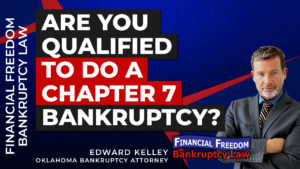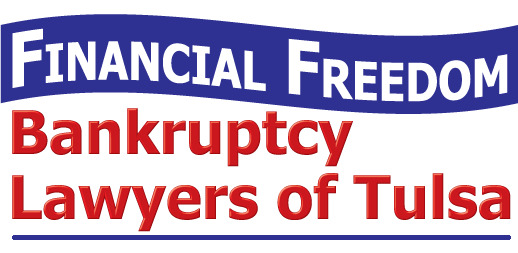Oklahoma Bankruptcy HelpAre You Qualified to File Chapter 7 Bankruptcy?
Your Income Has to Be Under a Certain Cap
Video Transcribed: Oklahoma Bankruptcy Attorney Edward Kelley with Financial Freedom of Tulsa, helping you solve all of your financial problems with the power of the federal bankruptcy code. So this is my little introduction series. It’ll change from time to time.
But since you’ve reached out asking about bankruptcy, or you have some questions, I’m going to do a quick three-part series on chapter 7 bankruptcy. It’s what the majority of people are reaching out for. That means get rid of all your debt once and for all, quickly and done.
So video number one, can you do it? Are you qualified to do a chapter 7 bankruptcy? Well, that’s pretty simple. In order to do an Oklahoma Chapter 7, first, your income has to be under a certain cap and that’s based on your household size.
Now, your household may not be exactly what you think it is. If you’ve got five people in the house, but they’re roommates and you’re renting from a landlord, you probably got a single-person household. So you’re only going to use your income.
 And I’ll give you an example, in Oklahoma, it’s pretty generous in Oklahoma. Currently, you can make up to about $40,000 and still qualify as a single-person household to do a bankruptcy.
And I’ll give you an example, in Oklahoma, it’s pretty generous in Oklahoma. Currently, you can make up to about $40,000 and still qualify as a single-person household to do a bankruptcy.
And you can add roughly $9,000 to $10,000 on top of that per year, gross, for each person in the household. So if you’ve got you, your spouse and a child, a three-person household, you need to use both of your income, even if one of you is not going to do the bankruptcy, and then use that IRS standard.
For example, you’re up close to $60,000 in gross per year to qualify. So you can ballpark it. And if your expenses are unusual, you have ongoing out-of-pocket medical, you’ve got a high mortgage then that can pull you back down. So certainly don’t be afraid. Now, if you’re $50,000 a year over, then you’re looking into chapter 13, which I’ll talk about in another video. But there are options there too.
So first, income cap. How many in your household? The figure for one person, about $40,000, adds $9,000 or $10,000 on top of that. As long as you’re under that, no problem.
Next thing, this is not a question of whether you can do it, but this is a question of whether you want to do it. So chapter 7 works this way. The government says, “Hey, we’ll take any assets you have that are not exempt, meaning protected and we can’t touch them, and in exchange, get rid of all your debt.
So what’s exempt? Your home, in the city, limits up to an acre, for all intents and purposes unlimited. 60 acres out in the country, again, for all intents and purposes unlimited. So it can be tricky if you have more than an acre in the city limits. Something to think about. But otherwise, you’re okay there.
And your car per spouse is $7,500. And you can’t trade that back and forth. So each of you has up to $7,500 in an exemption on a vehicle. So what that means. So you’ve got a late model Escalade that you want to keep, well, it’s your equity. It’s not how much it’s worth.
So maybe it’s worth $50,000, but you owe $60,000. That means you’re upside down. That means the trustee in your bankruptcy can’t do anything. That’s not really an asset. And as long as your equity, meaning what you owe minus what it’s worth, is not one $7,500 then you’re fully protected.
Now, if you have other assets, stocks, bonds, oil royalties come up a lot in Oklahoma. Any of these things are not exempt. So if you’ve got something of value outside of your car and your home, they don’t take your incidentals, your TV and your couches, things like that, then you want to think about it.
So that’s the second thing. So you’ve made the income cap. And I should also mention social security does not count toward qualifying. So if part of that income is social security, you’re probably still going to make it in. Then you want to see, do I have any assets that are going to cause me any trouble?
And then the last thing is, do I have any collateral that I’m worried about losing tied to any of those loans? So we call that the reaffirmation process. For example, we talked about cars, you’ve got a note on your car and you want to keep it you’re going to have to reaffirm that loan.
And is that something you can afford going forward? Have you got a secured loan with a furniture company for everything in your house? Again, you’re going to have to reaffirm it. You can’t just get rid of that without reaffirming it.
If so, do you have money to be able to pay for those things? You may end up deciding, “Hey, I’m going to get rid of that Escalade. That’s really not a good idea. I’m getting a fresh start in every other way.”
Because if you do reaffirm, you’re stuck with it. But anyway, that’s the quick calculation. Can I do a chapter 7? And then in our next video, part two of our Intro to Bankruptcy, we’re going to talk about how does it work. So I will see you then.




